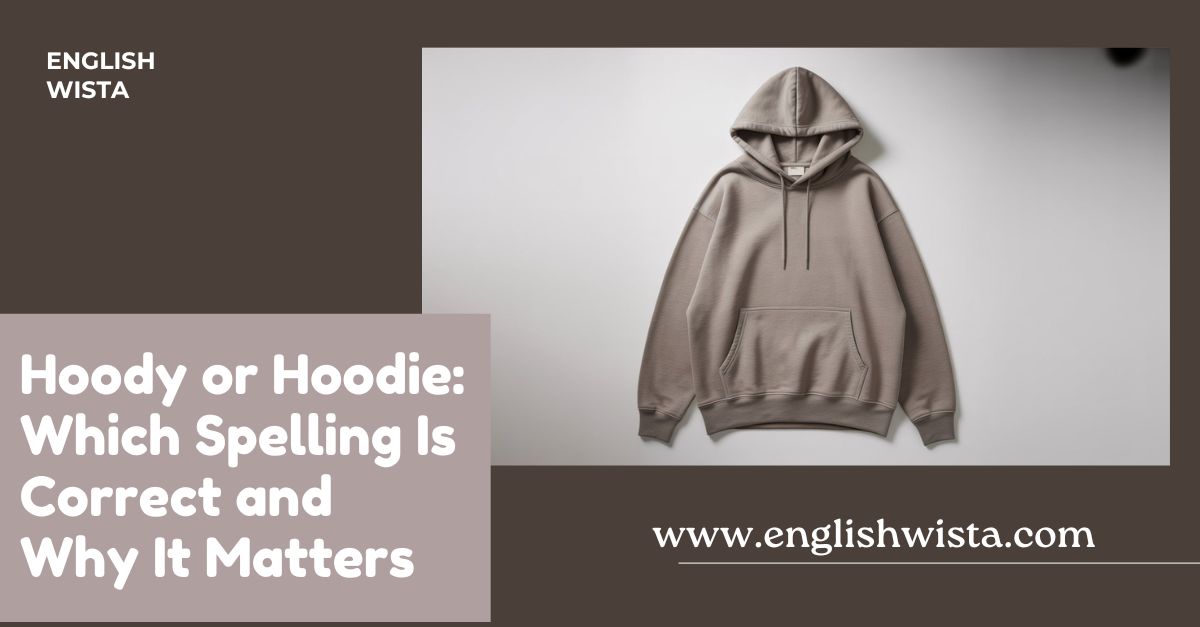Have you ever shopped for clothes online and noticed that some websites write “hoody” while others use “hoodie”? If you’ve ever paused for a second and wondered which one is correct, you’re not alone. Many people see both versions of the word and get confused. After all, we’re talking about the same cozy sweatshirt with a hood, right? So, is it “hoody” or “hoodie”?
In this article, we’ll break down the difference between the two spellings, explain where they come from, and give you plenty of examples so you’ll never second-guess yourself again. Don’t worry we’ll keep it simple, friendly, and fun, just like chatting with a friend.
Let’s dive in and settle the debate once and for all!
What Does the Word Mean?
Before we compare spellings, let’s make sure we’re clear on what the word itself means.
A hoodie (or hoody) is:
- A casual sweatshirt or jacket.
- It has a hood attached.
- Often comes with drawstrings and sometimes with a pocket in the front.
In short, it’s the comfy piece of clothing most people wear when they want to feel relaxed or cozy. Think of lazy weekends, a morning jog, or chilly evenings hoodies are everywhere!
So the meaning doesn’t change. Whether you spell it “hoody” or “hoodie,” we’re still talking about the same garment.
Hoody vs. Hoodie: Which One Is More Common?
Now comes the fun part: the spelling difference.
- Hoodie (with “ie”) is by far the most common spelling. If you browse big online stores like Amazon, Nike, or Adidas, you’ll notice they all use “hoodie.”
- Hoody (with “y”) is much less common. You’ll see it sometimes, but usually on UK-based websites or smaller brands.
In other words, both spellings exist, but “hoodie” has become the standard in most parts of the world.
Here’s a quick rule of thumb:
- If you’re writing for an international audience, go with hoodie.
- If you’re in the UK, you might see hoody here and there, but even there, “hoodie” is more widely recognized.
Why Are There Two Spellings?
Great question! The difference comes down to how English sometimes creates words from other words.
The word comes from hood, which is the part of the garment that covers your head. When we add a playful ending to describe something, English often uses -ie or -y. For example:
- Dog → doggy or doggie
- Cat → kitty (different but same idea of softening a word)
- Mum → mummy
So “hood” became:
- Hoody (hood + y)
- Hoodie (hood + ie)
Both make sense, but “hoodie” with “ie” looks friendlier and has become more popular over time.
Is One Spelling More Correct Than the Other?
Technically, both are correct. English is flexible like that. But if you’re worried about “proper” usage, here’s what to know:
- Dictionaries like Merriam-Webster and Oxford list hoodie as the main spelling.
- “Hoody” is sometimes mentioned as a variant spelling, but not the main one.
So, if you want to be safe and understood everywhere, stick with hoodie.
Example Sentences with “Hoodie”
Let’s see how it looks in action:
- I wore my favorite hoodie to the park.
- She bought a new black hoodie for the winter.
- Do you want to borrow my hoodie? It’s really warm.
Example Sentences with “Hoody”
And now with the alternate spelling:
- He left his blue hoody at school.
- That shop sells a cool zip-up hoody.
- She designed her own custom hoody with a logo.
As you can see, both look fine, and both are understandable. It’s just that you’ll see “hoodie” more often in daily life.
Do People Use Them Differently in the UK and US?
Yes, a little.
- In the United States, “hoodie” is almost always used. You’ll rarely see “hoody.”
- In the United Kingdom, both spellings appear, but “hoodie” is still winning. “Hoody” might pop up more often in British shops or informal writing.
So, the US is firmly “hoodie,” while the UK sometimes mixes both.
Where Did the Word Come From?
Let’s talk about history for a moment.
The word hood is very old. It comes from Old English “hōd,” which meant a head covering. Over centuries, clothing with hoods became common in different forms, from medieval monks’ robes to capes.
The modern hoodie as we know it today started in the 1930s in the US. It was first designed as workwear for people in cold warehouses. Later, athletes and students began wearing them, and they became linked with sports, fashion, and even youth culture.
The spelling “hoodie” seems to have caught on more during the late 20th century, probably because it looked catchier and friendlier for marketing.
Why Does “Hoodie” Feel More Natural?
Think about other casual clothing terms. Many of them use a playful -ie ending:
- Beanie (a knit cap)
- Onesie (a one-piece outfit)
- Bootie (a small boot, often for babies)
Adding “ie” makes the word feel less stiff and more fun. That’s another reason why “hoodie” became the standard spelling. It just feels right for a cozy, relaxed piece of clothing.
Can You Use “Hoody” in Formal Writing?
If you’re writing a school essay, a fashion blog, or even product descriptions, go with hoodie. It’s the safer, more professional choice. “Hoody” won’t be marked as wrong, but it might look like a typo to some readers.
Fun Facts About Hoodies
Here are a few extra tidbits to keep things interesting:
- Pop culture: Hoodies became famous in movies like Rocky and through hip-hop culture in the 1970s and 80s.
- Symbolism: Sometimes, hoodies have been linked with rebellion or streetwear culture, while at other times, they represent comfort and coziness.
- Global trend: Today, almost everyone owns at least one hoodie, no matter their age or background.
Quick Recap
Let’s keep it simple:
- Both hoody and hoodie mean the same thing: a sweatshirt with a hood.
- Hoodie is the standard, most common spelling.
- Hoody is rare, mainly in some UK contexts.
- Dictionaries and brands prefer hoodie.
- If in doubt, always go with hoodie to avoid confusion.
Conclusion
So, hoody or hoodie which should you use? While both spellings are correct, “hoodie” has clearly become the favorite worldwide. It’s the version you’ll find in dictionaries, online shops, and most people’s everyday writing.
If you want to keep things simple and safe, stick with “hoodie.” But if you spot “hoody” somewhere, don’t be confused it’s just the less common twin of the same cozy garment.
Next time you grab your favorite hoodie (or hoody, if you prefer), you’ll not only be warm and comfortable, but also confident in knowing exactly how to spell it.



